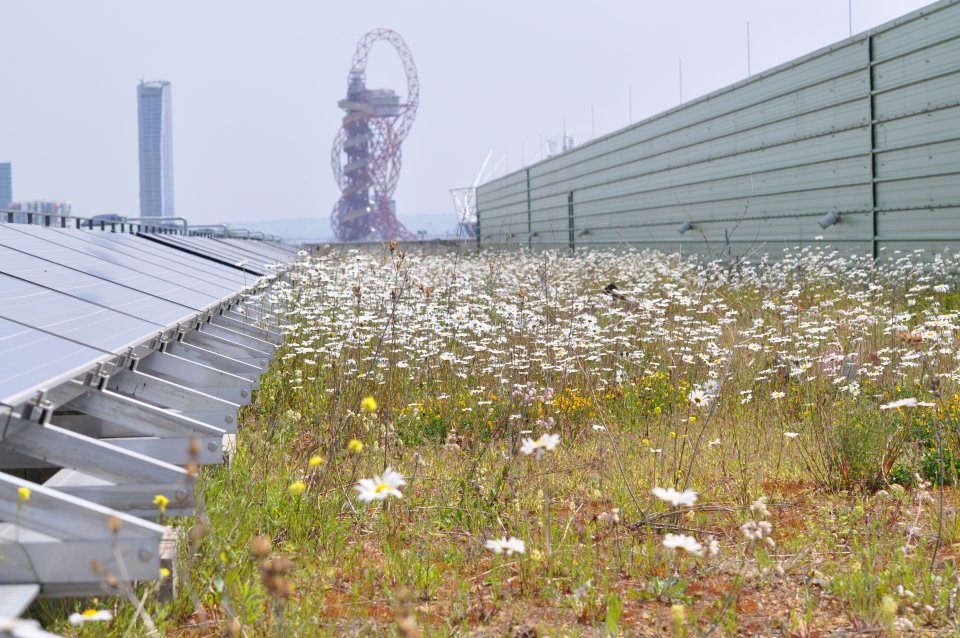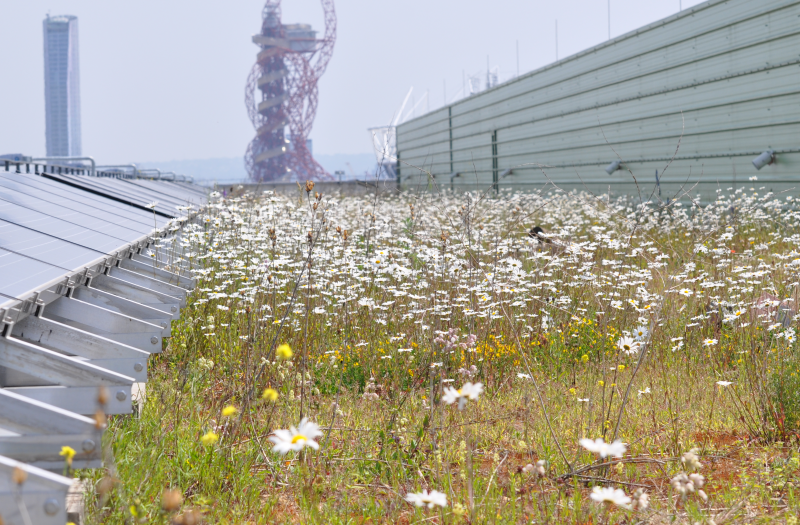London - NbS for a leading sustainable city

The Greater London Authority (GLA) participants in the BRIDGE FP7 project identified the primary planning goals for the Central Activities Zone (CAZ)[1] as to: (a) increase green space; (b) improve air quality; (c) reduce the UHI effect (heat island) and (d) prevent flash floods, with climate change adaptation and mitigation seen as a cross cutting issue.
London has a number of plans aimed at addressing these challenges, including:
- The Mayor’s London Plan in which two goals relate to urban green space and aim at addressing vegetation loss, overheating and flooding. To address the former it was envisioned to plant 2 million trees and to increase green space by 5 % by 2030 and another 5 % by 2050 (2011a), with the street tree programme especially targeting areas known to experience overheating. It also has a Living Roofs and Walls scheme focused on creating green roofs and recreational living roofs and green walls to help London adapt to the risks of climate change such as flooding, overheating, drought; and reducing the urban heat island effect in the city (GLA, 2008). The London Plan also has some measurable objectives, including a no net loss of designated Sites of Importance for Nature Conservation over the plan period, a reduction in CO2 emissions to 23 % below 1990 levels by 2016, no net loss of functional flood plain and the production of 945 GWh of energy from renewable sources by 2010 including at least six large wind turbines.
- The London Infrastructure Plan 2050 sees green infrastructure (GI) as important in its own right and seeks to develop a business case for it (Mayor of London, 2015). The GLA has set up a Green Infrastructure Task Force to work on a more strategic and long-term approach to investing in and delivering green infrastructure.
- The Mayor’s plan for an All London Green Grid (ALGG) sought to achieve a network of high quality, well-designed and multifunctional green and open spaces and to promote a shift from grey to green infrastructure to secure environmental, social and economic benefits (GLA, 2012). Such a grid was seen as the way to address the environmental challenges of the 21st century — most notably climate change.
- The Natural Capital Investing in a Green infrastructure for Future London (GLA, 2015) takes forward ideas for the ALGG. It has the vision that by 2050 existing parks and green spaces will become part of an integrated GI network, all regeneration areas and major new developments will include GI (e.g. green roofs and walls) that is designed, amongst other things, for climate mitigation, water regulation and health; streets will be greener and more of London’s rivers will run in more natural courses in order to manage flooding, improve water quality and enhance river ecology. It also wants all people living in London to have ready access to good quality GI and for GI decisions to be based on natural capital valuation.
- The Mayor’s Air Quality Strategy (GLA, 2010) aimed to minimise greenhouse emissions and the health effects of air pollution through increasing energy efficiency and including air quality impacts in the planning process. It aimed to encourage the development of green roofs and living walls on major new developments, recognising their benefits (and that of GI as a whole) in reducing pollutants, as well as improving energy consumption, the physical environment and helping control runoff.
- The Mayor’s Climate Change Adaptation Strategy (GLA, 2011b) identified health, environment, economy and infrastructure as key focus areas. It recognised the importance of green spaces in providing ecosystem services, such as reducing flood risk by absorbing and temporarily retaining rainfall and moderating the temperature by offsetting the urban heat island effects, as well as reducing energy demand and supporting biodiversity and recreation. It also set out a vision for a Green Grid across London. The GLA also emphasised the importance of climate adaptation measures and included the suggestion of new trees for shade and green roofs for electricity substations.
- The Mayor’s Water Strategy (GLA, 2011c) outlines how London can ensure water security and tackle water scarcity and sees GI as contributing to resilience to flooding and extreme weather events, as well as improving air quality. It includes a vision to develop at least three demonstration projects to show how urban greening measures can help to manage surface water flood risk.
[1] The CAZ covers the central London area, including the central business area and the commercial centre, with an overall area of roughly 3 300 ha and about 280 000 residents (BRIDGE Community of Practice Report 2).
A very large number of NbS projects have been undertaken in London and the potential for different NbS have been assessed by the GLA, including green walls and roofs (GLA, 2008). The examples below are all taken from EU funded projects.
The TURAS (FP7 project) work on green roofs compared...
- Cost-effectiveness
The GLA have estimated that an average of 32 % of roof area could potentially be greened (GLA, 2008) and two options have been explored (GLA, 2008). The first is to install green roofs covering an area of 226 750 m2 in four inner city areas, which would cost around GBP 4 million (EUR 4.5 million, exchange rate 7 November 2017) and provide environmental benefits worth GBP 4 million (EUR 4.5 million, exchange rate 7 November 2017). The second option would comprise a much larger area with 3.2 million m2 of roof space and would cost around GBP 55.5 million (EUR 63 million, exchange rate 7 November 2017), but with additional environmental benefits. A 850 m2 retrofitted green roof on a building in Canary Wharf, has achieved an estimated reduction of 25 920 kWh [11.46 CO2 eq. tonnes] a year through reducing heating and cooling of the spaces below the roof, with an estimated saving of up to GBP 4 000-5 000 per year in electricity [pers.comm. Tony Partington Canary Wharf Co. in GLA, 2008].
The River Quaggy project found that the NWRM costs were generally lower than those for more ‘traditional’ measures, and while the costs associated with re-meandering the channel and creating the detention basin were not small, a greater range of (multiple) benefits was achieved (NWRM, no date).
- Lessons learned
The River Quaggy project identified a number of key lessons including the importance of early and continued consultation during all phases of the project to develop project ownership by the community (NWRM, no date). This helped in the implementation and operation of the setback flood defences in a highly residential area, by the use of private gardens. The project employed a full-time public liaison officer during the planning and implementation phases. Communication and a positive attitude are essential. A catchment-scale approach allowed for greater overall improvement by enabling some measures that could not have been implemented in isolation.
Lessons from the TURAS work in London include: getting NbS implemented takes longer than expected, so allow for this; while one can control a small-scale experiment one cannot control things in practice when dealing with nature, so one has to be flexible; there is a need to embed monitoring progress in the design phase as it is very hard to retrofit it and that legacy management needs to be planned at an early stage (Connop, pers. comm).
The Land Trust has developed a service charge financial model for developers to ensure green space is well-maintained in the long term. This model involves residents within all new houses contributing to the annual costs of maintaining the green spaces, with the funding also covering some of the...
Peter Massini, Principal Policy & Programme Officer, Green Infrastructure Development, Greater London Authority
